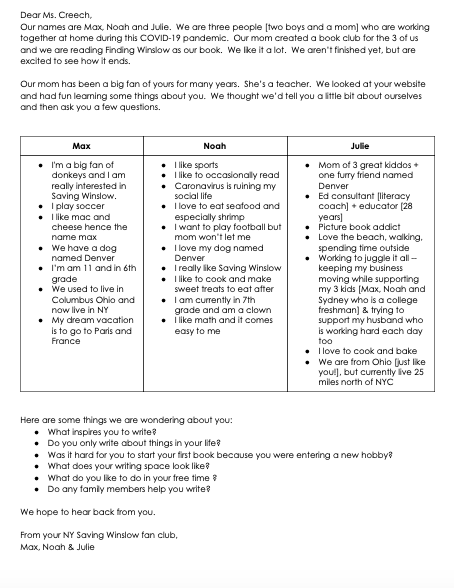We offer you Short Texts at Your Fingertips. Twice each week, we provide teaching ideas around a different type of short text that is easily found in the home, so that no family feels under-resourced. These ideas can integrate into virtually any curriculum and pedagogy, from Workshop to basal. If you are a caregiver, teacher, or curriculum director, these brief but mighty texts and lessons are our way of saying thanks. And our way of giving children authentic and enjoyable reading and writing engagements each day.
Written by Julie Wright & Elizabeth Keim
SHORT TEXTS AT YOUR FINGERTIPS: JOKES & RIDDLES
We all need to laugh, perhaps now more than ever. Children love jokes, they love to hear them and they love to tell jokes themselves. Joke telling is a particular skill: timing is everything and it is important to remember the punchline (something that our youngest comics sometimes find difficult - which is also funny in itself). Jokes are the perfect short texts. They are bite-sized and easy to find. Riddles are a bit longer and can be more complex. Guessing the answer is fun too! Jokes and riddles are the perfect way to explore language and make meaning.
VIDEO
Take a look at this short video on how to use jokes and riddles to entertain, inform, and inspire.
TRY THIS!
Step 1
Think about the jokes and riddles you already know, or look for some new ones
Sources of jokes and riddles:
Joke books
Websites [see resources below for some links to our favorites]
Family members
Tell or read the joke to someone:
What do you notice about the structure of the joke?
What do you wonder?
What makes a joke funny?
How can you solve a riddle?
Step 2
Take a closer look:
What makes it funny?
What is the structure? How does the joke or riddle “work”?
Here’s an example of a joke we learned as children:
Knock, knock
Who’s there?
Dwayne
Dwayne who?
Dwayne the bathtub, I’m dwownding!
Here’s what we noticed:
All “Knock, knock” jokes follow a very prescribed “formula.”
It is a type of question and answer joke.
It is based on word play, these jokes always involve words that sound like other words (i.e. Dwayne and Drain).
This joke is filled with reading, writing and talking opportunities. For example, you could:
Talk about what makes this joke so funny.
Write some of your own Knock, knock jokes based on names you know that sound like other words.
Read more Knock, knock jokes or others that follow a question and answer format.
MORE ABOUT JOKES & RIDDLES
Step 3
Look for other reading, writing and talking opportunities using this short text type.
Reading Ideas
Read many of a particular type of joke and analyze the structure.
Why do jokes make people laugh? Try to find the “funny part.”
Read many riddles and try to solve them before reading the answer.
Also read puns and tongue twisters - they also have prescribed structures.
Writing Ideas
Write your own jokes. Try writing a knock-knock joke.
Write your own riddle. Try a riddle about an animal or a number.
Write a caption for a picture riddle.
Think about your audience and write for them. [Reminder: Everyone does not appreciate “potty” jokes.]
Talking Ideas
Jokes work best if memorized and “told.” Learn a joke to tell on Flipgrid with your class, when in a Zoom meeting with friends or family, or as an ice-breaker in your instructional videos.
Put jokes together into a comedy routine. What jokes work well together?
Watch a family friendly comic. Laugh together. Discuss why the comic was funny and why it feels so good to laugh.
Use reasoning skills to solve riddles.
Step 4
Look for other jokes and riddles that you find and read those too!
FOR MORE RESOURCES, CHECK THESE OUT!
Joke books:
The Big Book of Silly Jokes for Kids: 800+ Jokes! by Carole Roman [current favorite!]
The Challenging Riddle Book for Kids by Danielle Hall
Websites:
COMING SOON!
Short Texts: Mighty Mentors That Move Readers and Writers Forward by Julie Wright & Elizabeth Keim (2022)
CO-AUTHOR: ELIZABETH KEIM
Elizabeth Keim is a New York City based educator with more than 25 years of experience. She is currently an AIS Reading Teacher/Reading Recovery teacher for a school in Mamaroneck, New York. Previously she taught in District 2 in Manhattan, serving as a classroom teacher, reading specialist, and library teacher. In each of these roles, she knows that, "it is all about finding a text that truly captures a particular reader." She has taught Undergraduate and Graduate level courses at New York University and Bank Street College of Education, as well as workshops for teachers and parents. An avid birder, Elizabeth enjoys her time in Central Park every spring and fall. Her most thrilling sightings to date are: A rare Kirtland's warbler and the tutti frutti colored Summer Tanager.













